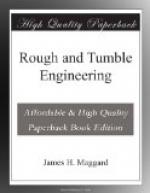These tests, however, are only for the purpose of trying your flues and are not intended to ascertain the efficiency or strength of your boiler. When this is required, I would advise you to get an expert to do it, as the best test for this is the hammer test, and only an expert should attempt it.
Part six ________
Any young engineer who will make use of what he has read will never get his engine into much trouble. Manufacturers of farm engines to-day make a specialty of this class of goods, as they endeavor to build them as simple and of as few parts as possible. They do this well knowing that, as a rule, they must be run by men who cannot take a course in practical engineering. If each one of the many thousands of engines that are turned out every year had to have a practical engineer to run it, it would be better to be an engineer than to own the engine; and manufacturers knowing this, they therefore make their engines as simple and with as little liability to get out of order as possible. The simplest form of an engine, however, requires of the operator a certain amount of brains and a willingness to do that which he knows should be done; and if you will follow the instructions you have already received, you can run your engine as successfully as any one can wish as long as your engine is in order, and, as I have just stated, it is not liable to get out of order, except from constant wear, and this wear will appear in the boxes, journals and valve. The brasses on wrist pin and cross-head will probably require your first and most careful attention, and of these two the wrist or crank box will require the most; and what is true of one is true of both boxes. It is, therefore, not necessary to take up both boxes in instructing you how to handle them. We will take up the box most likely to require your attention. This is the wrist box. You will find this box in two parts or halves. In a new engine you will find that these two halves do not meet on the wrist pin by at least one-eighth of an inch. They are brought up to the pin by means of a wedge-shaped key. (I am speaking now of the most common form of wrist boxes. If your engine should not have this key, it will have something which serves the same purpose.) As the brasses wear you can take up this wear by forcing the key down, which brings the two halves nearer together. You can continue to gradually take up this wear until you have brought them together. You will then see that it is necessary to do something, in order to take up any more wear, and this “something” is to take out the brasses and file about one-sixteenth of an inch off of each brass. This will allow you another eighth of an inch to take up in wear.




